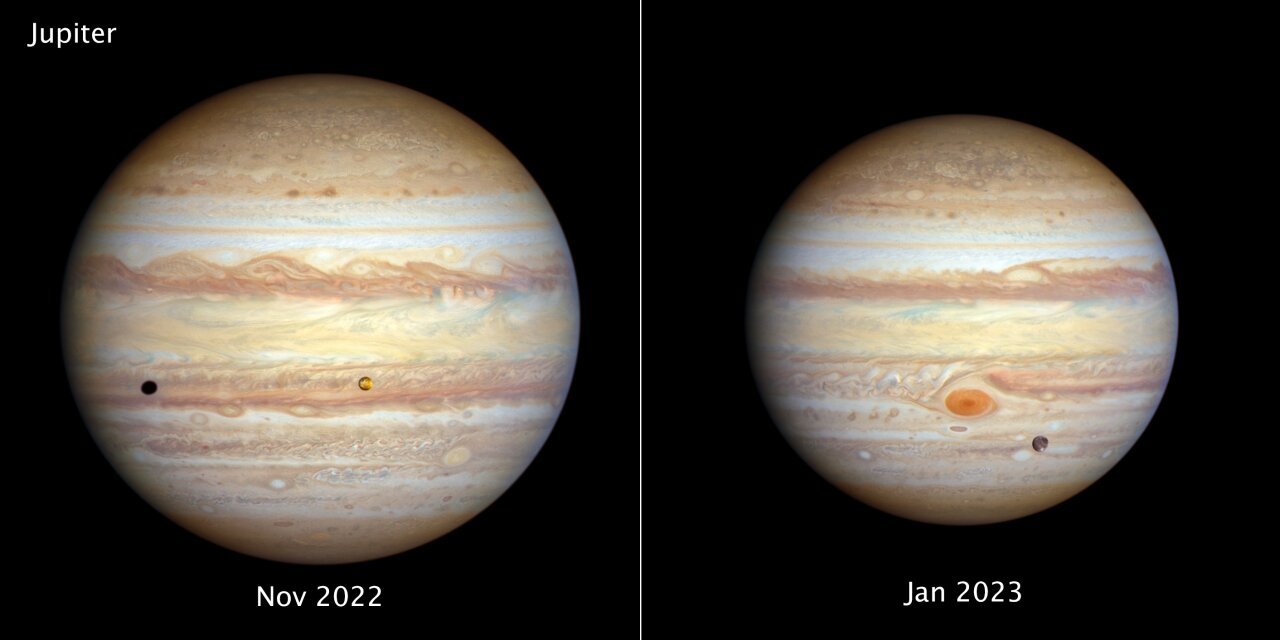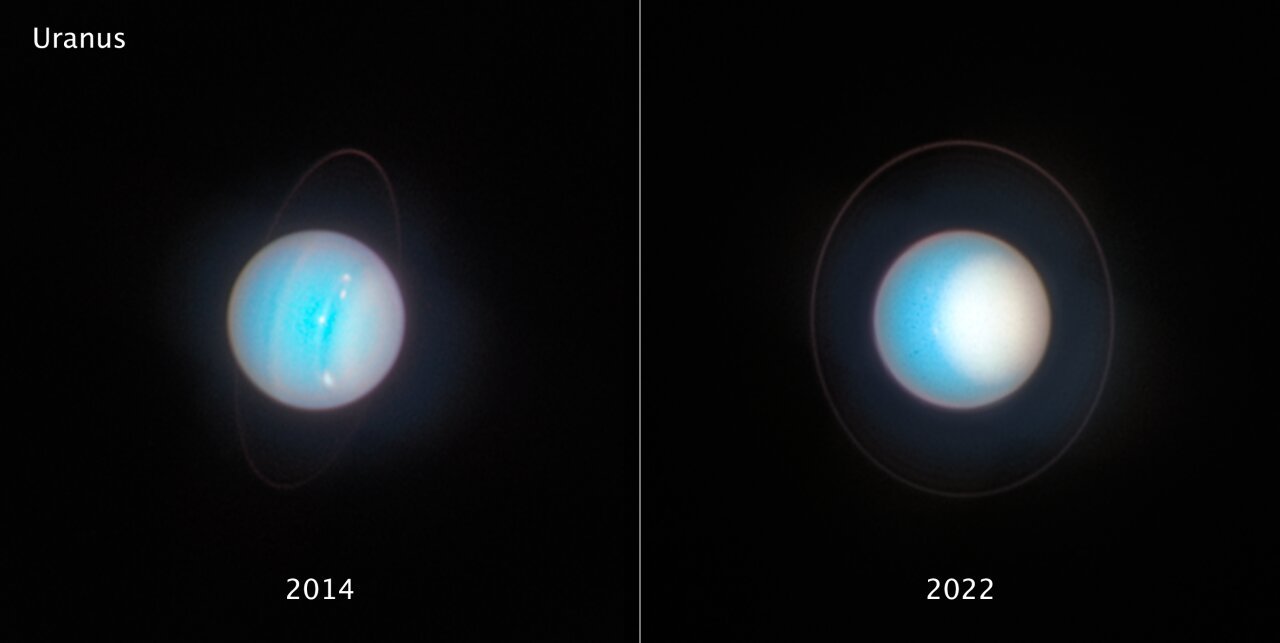NASA’s Hubble Space Telescope has been capturing breathtaking images of the changing weather and seasons on Jupiter and Uranus since its launch in 1990. Although the close-up views provided by other spacecraft, such as Juno and Voyager very impressive, however, Hubble’s sharpness and sensitivity enable it to track complex activities in these largely gaseous outer planets over time. Recently released images from Hubble OPAL Program showcase the stormy weather on Jupiter’s northern latitudes, the shrinking of the Great Red Spot, and the thickening of Uranus’ north polar haze.
These stunning views offer scientists valuable insights into these distant worlds’ mysterious atmospheres and unique characteristics while also captivating the public’s imagination. Astronomers are studying the effects of atmospheric circulation, particle properties, and chemical processes that control how the atmospheric polar cap changes with the seasons.
Now come to the point,
What is the Hubble OPAL Program?
Hubble OPAL Program is a long-term project that aims to study the atmospheric dynamics and evolution of the outer planets in our solar system. It uses the Hubble Space Telescope to observe Jupiter, Saturn, Uranus, and Neptune. The project will continue to make yearly observations throughout Hubble’s operation. The comments obtained through OPAL will be valuable for planetary scientists. This will allow researchers to study changes in the atmospheres of gas giants such as Jupiter over time. In addition, OPAL will observe the outer planets using a wide range of filters. This approach will provide insights into the composition and chemistry of their atmospheres. Scientists can better understand the complex processes shaping these gas giants by studying the planets this way.
An ellipsoid limb-fitting technique is used to process the images obtained through OPAL. This technique involves fitting an ellipsoid to the limb of the planet (the boundary between the planet’s atmosphere and space), allowing researchers to determine the planet’s size and shape. Scientists applied an additional fringe correction to the narrow-band filters only to correct for any errors in the observations. Then the scientists combine the images obtained through OPAL into mosaics for each observed filter. These mosaics are created in a projection that spans 360 degrees of longitude, allowing researchers to study the planet’s entire surface in a single image. The data obtained through OPAL will help us better understand the outer planets in our solar system and the processes that shape their atmospheres.

So, the question here is
What new insights have the Hubble telescope provided on Jupiter’s storms?
Thanks to the Hubble telescope, we have new insights into Jupiter’s storms. The telescope has revealed activity inside the storms that were not visible in the 1990s. For instance, it has detected built-in thunderstorms within cyclones and anticyclones. Astronomers took the image on the left on November 12, 2022. However, an astronomer captured the image on the right on January 6, 2023. Astronomers took the photo since Jupiter was 81,000 miles further from Earth, the planet appears smaller.
Hubble also shows strong color differences in Jupiter’s storms, indicating different cloud heights and depths. Recently, the Hubble Space Telescope captured some new images that provide exciting insights into Jupiter’s weather patterns and planetary phenomena. These images allow us to observe Jupiter’s atmosphere and study its storms and other features in greater detail. In addition, Hubble has also detected new activity within the storms that could shed light on the planet’s weather patterns.
Moreover, we should know
What causes Jupiter’s “vortex street” of storms, and how could they merge?
The “vortex street” of storms on Jupiter is caused by a wave pattern of nested anticyclones and cyclones that are locked together like gears moving clockwise and counterclockwise. Planetary astronomers have noted that if the storms were to merge, they could form a more significant storm rivaling the size of the Great Red Spot. This means that in the unlikely event that these storms get close enough to each other, they could merge and build an even more significant storm, rivaling the current size of the Great Red Spot. Jupiter’s Great Red Spot has shrunken to the smallest size it has ever been over observation records dating back 150 years.
Another thing that you need to know is,
What do we know about Jupiter’s moons and their surface features?
Hubble telescope’s sharp resolution captured Jupiter’s orange moon Io passing by, casting a shadow over Jupiter’s multicolored cloud tops. Io’s colorful appearance is due to its numerous active volcanoes, which eject sulfur in various hues at different temperatures. This sulfur creates a mottled-orange appearance on the moon’s surface. These volcanoes were first observed by the Voyager 1 spacecraft in 1979 and are located on a thin crust overlying the moon’s molten interior.
The colors on its surface tell us about the different temperatures and materials present in its volcanoes. The largest moon in the solar system, Ganymede, can be observed passing by Jupiter in the lower right of the image. With a size slightly larger than Mercury, it is characterized by a heavily cratered and mainly water-ice surface, and there are glacial flows that appear to be influenced by internal heat.

Here arises a question:
What has Hubble OPAL Program revealed about Uranus’ atmosphere and storms?
Hubble has revealed many details about Uranus’ atmosphere and storms. The telescope has detected multiple storms above the planet’s cyan-tinted lower atmosphere. These storms have methane ice-crystal clouds and are located at mid-northern latitudes. Additionally, Hubble has observed a thickened photochemical haze at the north pole.
Moreover, Uranus’s axis is tilted at an angle of eight degrees off the plane of its orbit. Due to this unusual rotation axis, Uranus is considered an “oddball” planet. Moreover, the north polar cap continues to get brighter year after year as Uranus approaches its northern summer solstice in 2028, allowing for good views of the rings and north pole.
Now you probably be thinking,
How did Uranus become tilted on its side?
There are different theories about how Uranus became tilted on its side. One theory suggests that it collided with a massive moon during formation. Another theory proposes that it experienced other planetary impacts.
Uranus’ tilt leads to some consequences for the planet. Each hemisphere experiences long periods of darkness and sunlight exposure as it orbits the Sun. These periods can last up to 42 years, leading to significant variations in temperature and weather patterns on the planet.
Moreover,
What changes have Hubble’s observations revealed about Uranus’ rings, and what can we expect to see during Uranus’ northern summer solstice in 2028?
Hubble has observed that Uranus’ rings have changed over time. In 2007, the telescope captured photographs of the rings while they were edge-on. Seven years later, Hubble’s observations showed that the rings had started to open up.
Moreover, scientists expect some changes to occur during Uranus’ northern summer solstice in 2028. Scientists predict the north polar cap to grow brighter, and the ring system will appear face-on. This event will provide an excellent opportunity to view the rings and north pole in detail.





